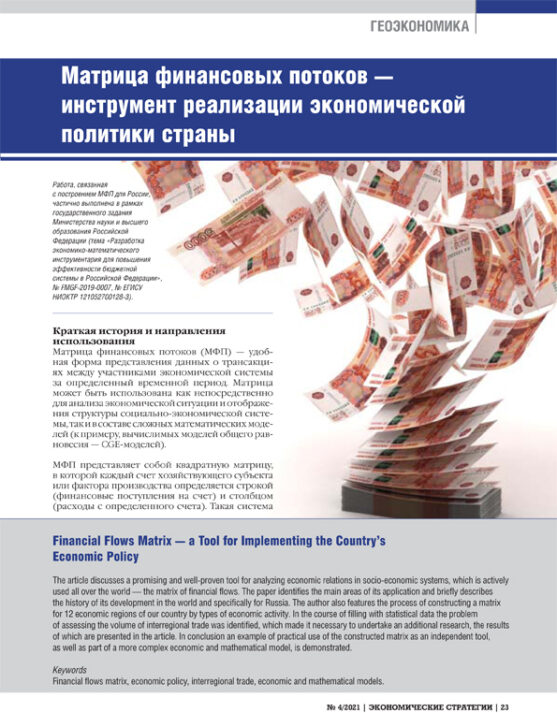Financial Flows Matrix — a Tool for Implementing the Country’s Economic Policy
DOI: https://doi.org/10.33917/es-4.178.2021.22-35
The article discusses a promising and well-proven tool for analyzing economic relations in socio-economic systems, which is actively used all over the world — the matrix of financial flows. The paper identifies the main areas of its application and briefly describes the history of its development in the world and specifically for Russia. The author also features the process of constructing a matrix for 12 economic regions of our country by types of economic activity. In the course of filling with statistical data the problem of assessing the volume of interregional trade was identified, which made it necessary to undertake an additional research, the results of which are presented in the article. In conclusion an example of practical use of the constructed matrix as an independent tool, as well as part of a more complex economic and mathematical model, is demonstrated
References:
1. Mainar-Causapé A.J., Ferrari E., McDonald S. Social accounting matrices: basic aspects and main steps for estimation, EUR 29297 EN, JRC Technical Reports. Publications Office of the European Union, Luxembourg, 2018, DOI: 10.2760/010600.
2. Stone R.N. Measurement of national income and the construction of social accounts: report of the Sub-Committee on National Income Statistics of the League of Nations Committee of Statistical Experts. With app., Definition and measurement of the national income and related totals. Geneva: U.N., 1947.
3. Stone R., Brown A. A Social Accounting Matrix for 1960 (with Alan Brown and others). N 2 in “A Programme for Growth”, Chapman and Hall, London, 1962.
4. Keynes J.M. The General Theory of Employment, Interest and Money. N.Y., 1936, available at: https://www.marxists.org/reference/subject/economics/keynes/general-theory/index.htm.
5. Baranzini M., Marangoni G. Richard Stone: An Annotated Bibliography. First ed., 2015, available at: https://core.ac.uk/download/pdf/43664097.pdf.
6. Social Accounting Matrices: a Basis for Planning (eds. G. Pyatt and J.I. Round), The World Bank, Washington, D. C., 1985.
7. Zakharchenko N.G. Ispol’zovanie matrits sotsial’nykh schetov v modelirovanii struktury ekonomicheskoi sistemy [Using Social Accounting Matrices in Modeling the Structure of the Economic System]. Prostranstvennaya ekonomika, 2012, no 1, pp. 69–89, DOI: 10.14530/se.2012.1.069-089.
8. Belousov A.R., Abramova E.A. Eksperimental’naya razrabotka integrirovannykh matrits finansovykh potokov 1988–1998 gg. [Experimental Development of Integrated Matrices of Financial Flows 1988–1998]. Moscow, INP RAN, 2003.
9. Vedev A.L. Izmeneniya v ekonomike Rossii v pervyi god rynochnykh reform. Analiz na osnove matrits finansovykh potokov [Changes in the Russian Economy in the First Year of Market Reforms. Analysis Based on Financial Flows Matrices]. Voprosy ekonomiki, 1993, no 6.
10. Volchkova N., Gorshkova E., Lobanov S., Makrushin A., Turdyeva N., Khaleeva Yu. Otsenka posledstvii reformirovaniya sistemy sotsial’nykh garantii: monetizatsiya l’got i reforma ZhKKh [Evaluating the Consequences of the Social Guarantees System Reform: Monetization of Social Benefits and Housing and Public Utilities Reform]. Moscow, TsEFIR, 2006.
11. Jensen J., Rutherford T., Tarr D. Documentation of Social Accounting Matrices for the Regions of Russia. Social Accounting Matrices For The Regions Of Russia, 2001. The World Bank, available at: https://datacatalog.worldbank.org/dataset/wps-4015-social-accounting-matrices-regions-russia-2001.
12. Akopov A.S., Beklaryan G.L. Metodika postroeniya integrirovannykh matrits finansovykh potokov (Social Accounting Matrix). Sravnitel’nyi analiz SAM dlya Rossii i Frantsii [Methods for Constructing Integrated Financial Flows Matrices (Social Accounting Matrix). Comparative SAM Analysis for Russia and France]. Audit i Finansovyi analiz, 2004, no 1, pp. 209–215.
13. Klimova N.I., Cherednikova L.Yu. Matritsy finansovykh potokov i ikh regional’nye prilozheniya [Financial Flow Matrices and Their Regional Applications]. Izvestiya Ufimskogo nauchnogo tsentra RAN, 2011, no 2, pp. 83–91.
14. Mikheeva N.N. Matritsy sotsial’nykh schetov: napravleniya i ogranicheniya ispol’zovaniya. ECO, 2011, no 3(6), pp. 103–118, available at: http://dx.doi.org/10.30680/ECO0131-7652-2011-6-103-118.
15. Vlasyuk L.I., Zakharchenko N.G., Kalashnikov V.D. Issledovanie regional’nykh makroekonomicheskikh proportsii i mul’tiplikativnykh effektov: Khabarovskii krai [Research of Regional Macroeconomic Proportions and Multiplier Effects: the Khabarovsk Territory]. Prostranstvennaya ekonomika, 2012, no 2, pp. 44–66.
16. Gromova O.V. Razvitie sistemy regional’nykh schetov: matritsa sotsial’nykh schetov [Development of the Regional Accounts System: Social Accounting Matrix]. Neirokomp’yutery: razrabotka, primenenie, 2013, no 2, pp. 070–079.
17. Tatarkin D.A., Sidorova E.N., Trynov A.V. Ispol’zovanie matritsy finansovykh potokov v modelirovanii ekonomicheskogo razvitiya regionov (na primere Sverdlovskoi oblasti) [Using the Financial Flows Matrix in Modeling the Economic Development of Regions (by the Case of the Sverdlovsk Region)]. Ekonomika. Nalogi. Pravo, 2015, no 1, pp. 92–99.
18. Animitsa P.E. Modelirovanie vliyaniya domokhozyaistv na sozdanie mul’tiplikativnykh effektov v regione (na primere Sverdlovskoi oblasti) [Modeling the Impact of Households on Creating Multiplicative Effects in a Region (by the Case of the Sverdlovsk Region)]. Upravlenets, 2016, no 2(60), pp. 28–33.
19. Soldatova S.E., Voloshenko K.Yu., Ogneva N.F. Matrichnoe predstavlenie pokazatelei sistemy regional’nykh schetov Kaliningradskoi oblasti: eksperimental’naya razrabotka i perspektivy modelirovaniya [Matrix Representation of Indicators of the Regional Accounts System of the Kaliningrad Region: Pilot Development and Modeling Prospects]. Baltiiskii region, 2015, no 3, pp. 126–137.
20. Naumov I.V., Trynov A.V. Modelirovanie investitsionnoi privlekatel’nosti vidov ekonomicheskoi deyatel’nosti v regione s ispol’zovaniem matritsy finansovykh potokov [Modeling the Investment Attractiveness of Economic Activities in a Region Using Financial Flows Matrix]. Ekonomicheskie i sotsial’nye peremeny: fakty, tendentsii, prognoz, 2019, no 4, pp. 53–66, DOI: 10.15838/esc.2019.4.64.4.
21. Zakharchuk E.A., Pasynkov A.F. Regional’naya balansovaya model’ finansovykh potokov na osnove sektoral’nogo podkhoda sistemy natsional’nykh schetov [Regional Balance Sheet Model of Financial Flows Based on the Sectoral Approach of the National Accounts System]. Ekonomika regiona, 2017, vyp. 1, pp. 318–330.
22. Dondokov Z.B. Mul’tiplikatsionnye effekty v ekonomike [Multiplier Effects in the Economy]. Ulan-Ude, Izd-vo VSGTU, 2000.
23. Stone R., Brown A. Behavioral and Technical Change in Economic Models. Problems in Economic Development, MacMillan, New York, 1965.
24. Gusev A.B. Oslablennaya ekonomicheskaya integratsiya regionov Rossii — ugroza territorial’noi tselostnosti strany [Weakened Economic Integration of Russian Regions — a Threat to the Territorial Integrity of the Country]. Obshchestvo i ekonomika, 2011, no 10, pp. 50–66.
25. Granberg A.G. Osnovy regional’noi ekonomiki [Fundamentals of the Regional Economy]. Ucheb. dlya vuzov. Moscow, GU VShE, 2000.
26. Obshcherossiiskii klassifikator ekonomicheskikh regionov. OK 024-95 (utv. postanovleniem Gosstandarta Rossii ot 27 dekabrya 1995 g. N 640) (v red. ot 10 fevralya 2021 g.) (data vvedeniya 1 yanvarya 1997 g.) [All-Russian Classifier of Economic Regions. OK 024-95 (Approved by Decree of the Gosstandart of Russia Dated December 27, 1995 No. 640) (as Amended on February 10, 2021) (Implementation date — January 1, 1997)]. Konsul’tant, available at: http://www.consultant.ru/document/cons_doc_LAW_115583.
27. Federal’naya sluzhba gosudarstvennoi statistiki, available at: http://www.gks.ru.
28. Ukaz Prezidenta RF ot 2 iyulya 2021 g. N 400 “O strategii natsional’noi bezopasnosti Rossiiskoi Federatsii” [Decree of the President of the Russian Federation of July 2, 2021 No. 400 “On the National Security Strategy of the Russian Federation”]. Ofitsial’nyi internet-portal pravovoi informatsii, available at: http://publication.pravo.gov.ru/Document/View/0001202107030001.



